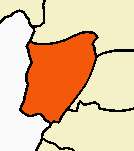Gudalur, Theni
| Gudalur கூடலூர் Lower Camp லொவர் கேம்பு | |
|---|---|
| Town | |
 Gudalur Location in Tamil Nadu, India | |
| Coordinates: 9°41′N 77°16′E / 9.68°N 77.27°ECoordinates: 9°41′N 77°16′E / 9.68°N 77.27°E | |
| Country |
|
| State | Tamil Nadu |
| District | Theni |
| Government | |
| • Type | Second Grade Municipality |
| • Body | Gudalur Municipality |
| Elevation | 1,182 m (3,878 ft) |
| Population (2011) | |
| • Total | 41,915 |
| Languages | |
| • Official | Tamil |
| Time zone | IST (UTC+5:30) |
Gudalur is a municipal town in Theni district in the Indian state of Tamil Nadu. As of 2011, the population of the town was 41,915.
Geography
Gudalur is located at 9°19′N 77°12′E / 9.31°N 77.20°E.[1] It has an average elevation of 1182 metres (3888 ft).
Demographics
According to 2011 census, Gudalur had a population of 41,915 with a sex-ratio of 1,006 females for every 1,000 males, much above the national average of 929.[2] A total of 3,355 were under the age of six, constituting 1,727 males and 1,628 females. Scheduled Castes and Scheduled Tribes accounted for 6.61% and .56% of the population respectively. The average literacy of the town was 66.83%, compared to the national average of 72.99%.[2] The town had a total of 12001 households. There were a total of 20,860 workers, comprising 799 cultivators, 13,578 main agricultural labourers, 637 in house hold industries, 4,206 other workers, 1,640 marginal workers, 22 marginal cultivators, 1,055 marginal agricultural labourers, 121 marginal workers in household industries and 442 other marginal workers.[3]
As per the religious census of 2011, Gudalur (M) had 92.31% Hindus, 5.25% Muslims, 2.34% Christians, 0.01% Sikhs and 0.1% following other religions.[4]
History
Gudalur is very beautiful place located in the western Ghats region. Different race and community people are living with harmony. They are united by doing agriculture activities. So the local festivals are based on the monsoon and paddy harvesting seasons. The majority population are belongs to Vokkaliga Gowders, historically they are Migrant settlers from the Mysore region of Karnataka who left due to political instability from the region during the 1760s to the 1790s started arriving in hordes and started clearing forests and tilling the land. They still speak Kannada language within their community and well mingled with local population. During the British period, after the enactment of the Criminal Tribes Act, several settlements were created by the government and members belonging to the notified communities were uprooted from their original habitations and settled here. The British officers posted in the area started regularizing land holdings based on good faith and track record.
The Gudalur Naattamai is credited with the creation and expansion of cardamom plantations in the neighbouring Kerala state and records to this effect were traced in the Village Office of Vandanmedu, Idukki District, Kerala recently.
Life here revolves around agriculture and almost everyone has something or the other to do with farming. This place is a village surrounded by paddy fields, vast expanses of arid land, diverse flora and fauna. Principal crops are paddy, pulses, coconut, grapes, vegetables, flowers and groundnut. Crops such as gingely and cotton are also extensively cultivated. Main source of water is from Periyar Dam. The Tamil Nadu government has undertaken a project to build a memorial for Col. John Penny Cuick, who built the Mullai Periyar Dam at Lower Camp, near Gudalur.
Gudalur is famous for the bullock cart (rekhla) racing heritage. Every year during the Muthalamman temple festival, bullock cart races takes place. This annual event is conducted by Vokkaliga Ilaingarani and The Farmers Development Association. Racing bull & cart such as All originals heroes is all school pupil. are veterans in this field with their bullocks winning many laurels in the entire state.
The Azhagar Swamy Temple (Thiru koodal azhagiya perumal) is said to be over 1,000 years old but evidences prove that they are probably 500 years old. The Poonjar (Poonaiyar) Rajas of Kerala are said to be the builders of this great temple. It is built with the same architecture of Madurai Alagar temple.
As per Kaval Kottam by Venkatesan (Sahitya Academy Award for this book) has written on his research The novel deals with the unique security system prevailed in Madurai Fort before it was demolished by the British for the purpose of expanding the city. The British defeated the security guards and lodged them in a camp in Gudalur - Cumbum Valley after declaring them as Notified Community. After independence, they were denotified.
The Mangaladevi Kottam, an ancient temple (now in ruins), which is dedicated to Kannagi, the Tamil goddess is situated very close to Gudalur. This temple site is under dispute between the Tamil Nadu and Kerala states and access to the temple is granted by the Kerala State only once every year.
Gudalur has had incidents of violence reported in the past, especially during the anti-Hindi agitations in 1965 and the few casteist clashes in the 1980s.
References
- ↑ AERCC - Theni
- 1 2 "Census Info 2011 Final population totals". Office of The Registrar General and Census Commissioner, Ministry of Home Affairs, Government of India. 2013. Retrieved 26 January 2014.
- ↑ "Census Info 2011 Final population totals - Gudalur". Office of The Registrar General and Census Commissioner, Ministry of Home Affairs, Government of India. 2013. Retrieved 26 January 2014.
- ↑ "Population By Religious Community - Tamil Nadu" (XLS). Office of The Registrar General and Census Commissioner, Ministry of Home Affairs, Government of India. 2011. Retrieved 13 September 2015.
External links
- http://temple.dinamalar.com/New.aspx?id=490
- http://temple.dinamalar.com/en/new_en.php?id=1032
- http://idukki.nic.in/thekkady.htm
